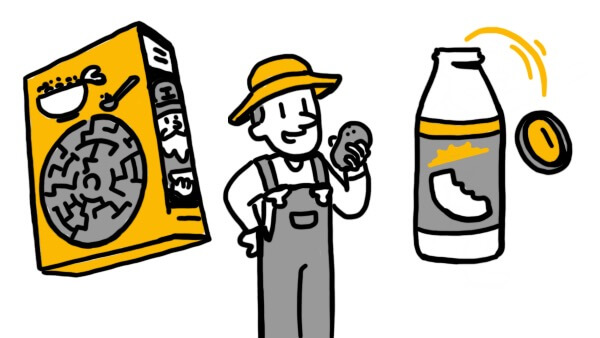Standing Out with Storytelling in CPG

If you’re in the consumer packaged goods (or CPG) space, you know better than most the unique advantages of challenges of the business. As Shopkick puts it, “Companies that produce or sell CPGs have the advantage of enduring demand, as consumers will always need these products… but, the CPG market is saturated, and switching costs are low for consumers who can easily substitute your brand for another.
In an environment where mere shelf placement can erase brand loyalty, how can you ensure your brand enjoys the benefits of the sector without succumbing to the pitfalls? Brand storytelling can go a long way in this effort, so let’s take a close look at storytelling can do to keep your brand at the forefront of consumers’ minds, even in a saturated market.
Bedrock Analytics proposes a fascinating place to draw guidance: Pixar. Describing the studio’s success as drawing from its storytelling even more than its visuals, Bedrock sketches the Pixar formula as proceeding along similar lines:
- Once upon a time, there was…
- Every day…
- Then, one day…
- Because of that…
- Because of that…
- Until finally…
The total accuracy of this storyline map isn’t as important as overall the success of it, and how storytelling has come to define Pixar as an animated film studio that exists a cut above the others. Do you need to follow this structure to succeed? Not necessarily, but you should follow a structure of some kind.
Establishing your structure of storytelling gives your consumers clear expectations for your brand’s narratives, and allows you to meet—or deviate from—those expectations to inform, entertain, or excite. Blue Bite uses a “Meet the Farmer Who Grew Your Bag” example when discussing storytelling for a potato chip brand.
This structure, which allows the consumer to learn about the farmer whose potatoes specifically went into their bag of chips, creates “an avenue to make brands that previously may have seemed impersonal meet the consumer on a one-to-one level.” In CPG, impersonal is unfortunately the norm—products tend to be used quickly and replaced, so getting the consumer to connect with your brand is more difficult than, say, a mobile device.
Snapple’s use of “Snapple facts” under their beverages’ caps was another great way to structure brand storytelling, and one that, like “Meet the Farmer,” was suitably quick and to the point. A single beverage doesn’t lend itself well to a lengthy narrative, but a quickly digestible fact was perfect to consume along with the drink. It established Snapple as fun, interesting, and a brand that promoted learning, in a miniaturized format that fit their product.
Shweta Menon goes further with her endorsement of CPG storytelling, calling it “the key differentiator” in the space. And her suggestions include using more than just packaging space to tell that story. “Incorporate QR Codes and NFC tags on your creative packaging to share your brand’s story,” writes Menon. These codes can lead to videos and more—allowing you tell a much fuller story than a package ever could. Menon goes on to share some convincing statistics on this approach’s efficacy.
“If consumers love a brand’s story, 55% of them are more likely to buy the product in the future, 44% will share the story, and 15% will purchase the product immediately.” It’s hard to argue with those numbers, especially since future purchases can be harder to secure in CPG. If your story is creative, unique, and easily accessible, consumers will take notice of your brand over others, and that shelf placement switching will be considerably easier to avoid.
And remember that storytelling can be a bit more complex than literally telling your story—just as Snapple more subtly told a story of inquisitiveness through its inclusion of Snapple factoids, gamification, quizzes, and other narrative-adjacent tools can create a brand story that resonates just as clearly as a literal story printed on your package.
This is what’s happening when cereal boxes include word searches or other stimulating activities on their boxes; the brand is telling a story of a company that cares about the enjoyment being had by its consumers.
When children trace a maze or scan a code (to use the higher-tech approach Menon promote), the brand is giving them more than cereal—it’s giving them something to think about, to have fun with, and ensuring that their brand appeals more than a cereal whose packaging supplies the bare minimum of nutritional facts. The story they’re hearing loud and clear is a story of collaboration, of a company whose interests involve their happiness. That is, indeed, a key differentiator.
Brand storytelling in CPG might seem hard, and in some ways, there are restrictions. Your consumer won’t be using each product they buy for years; in some cases, they might be finished with it in a matter of minutes. This does not mean that you should throw up your hands, however—far from it.
Telling a story that creates a personal connection helps consumers see your product as something more than one of several variants on a shelf. Storytelling can also send a broader message about the brand’s intentions, through approaches like gamification and other expectation-setting features that tell consumers that the company cares about their experience of the product.
Young or old, consumer engagement drives repeat purchases and separates your product from the competition. Just because a product doesn’t create a long-term-use relationship between itself and the customer doesn’t mean you can’t create one between your brand and the customer through effective storytelling.
How does your CPG organization tell your brand’s story? Do you agree that it is a key differentiator in a space where differentiation is key to success, or do you see another approach as central to maintained engagement? Do you use QR Codes and other mobile-friendly features to engage customers?
